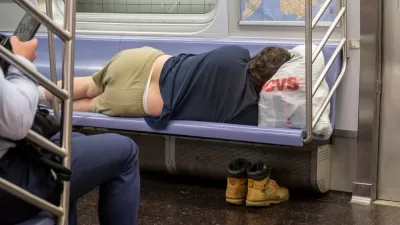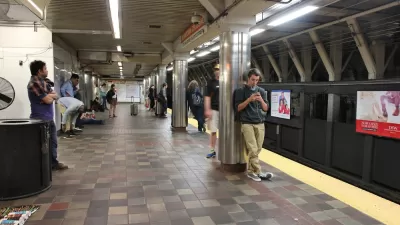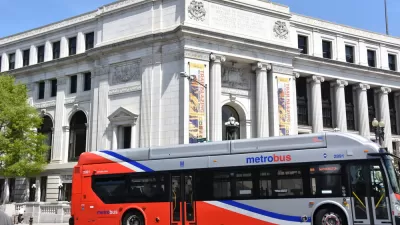A pilot project to extend the operating hours of Boston's subway system until 3 a.m. on weekends is being celebrated by riders, businesses leaders and public officials as a crucial element in maintaining a vibrant and attractive city.
To attract the talented young adults that are revitalizing America's cities, vibrant nightlife is essential. For cities wishing to cultivate their late-night scene, that means providing opportunities for partiers and employees to get home when the bars and clubs close without driving. Hence the motivation for Boston's political and business leaders to push for expanding the operating hours of the city's transit system.
"Boston is one of the few major cities in the United States where service barely inches past midnight: transit systems in New York, Chicago, and parts of Philadelphia run 24 hours, while Washington, D.C., has weekend service until 3," observes Martine Powers. "The addition of the later service in Boston will put employers on better footing when it comes to recruiting, especially in the technology sector."
“The biggest inhibitor to growth in the tech sector is our ability to attract and maintain talent,” said Tom Hopcroft, chief executive of the Massachusetts Technology Leadership Council. “There’s a big talent war going on, and New York and Silicon Valley are more appealing to young people. . . . There’s not a ton that’s holding them here, and oftentimes, it may be how fun and appealing the area is.”
“A vibrant economy demands a public transit system that caters to the residents, students and tourists it serves,” Governor Deval Patrick told The New York Times. “Extending service on weekend evenings will allow the public to enjoy the many attractions and restaurants the region has to offer and give workers a more cost-effective option for getting home late at night.”
FULL STORY: T’s late-night service plan could be arriving right on time

Study: Maui’s Plan to Convert Vacation Rentals to Long-Term Housing Could Cause Nearly $1 Billion Economic Loss
The plan would reduce visitor accommodation by 25,% resulting in 1,900 jobs lost.

North Texas Transit Leaders Tout Benefits of TOD for Growing Region
At a summit focused on transit-oriented development, policymakers discussed how North Texas’ expanded light rail system can serve as a tool for economic growth.

Why Should We Subsidize Public Transportation?
Many public transit agencies face financial stress due to rising costs, declining fare revenue, and declining subsidies. Transit advocates must provide a strong business case for increasing public transit funding.

How to Make US Trains Faster
Changes to boarding platforms and a switch to electric trains could improve U.S. passenger rail service without the added cost of high-speed rail.

Columbia’s Revitalized ‘Loop’ Is a Hub for Local Entrepreneurs
A focus on small businesses is helping a commercial corridor in Columbia, Missouri thrive.

Invasive Insect Threatens Minnesota’s Ash Forests
The Emerald Ash Borer is a rapidly spreading invasive pest threatening Minnesota’s ash trees, and homeowners are encouraged to plant diverse replacement species, avoid moving ash firewood, and monitor for signs of infestation.
Urban Design for Planners 1: Software Tools
This six-course series explores essential urban design concepts using open source software and equips planners with the tools they need to participate fully in the urban design process.
Planning for Universal Design
Learn the tools for implementing Universal Design in planning regulations.
Ascent Environmental
Borough of Carlisle
Institute for Housing and Urban Development Studies (IHS)
City of Grandview
Harvard GSD Executive Education
Toledo-Lucas County Plan Commissions
Salt Lake City
NYU Wagner Graduate School of Public Service





























